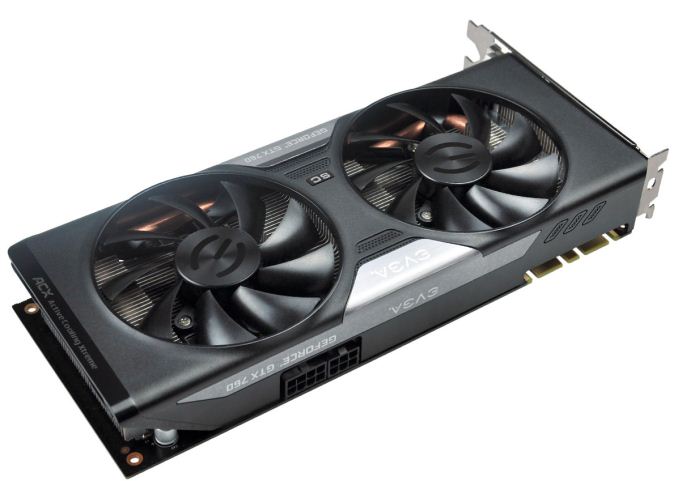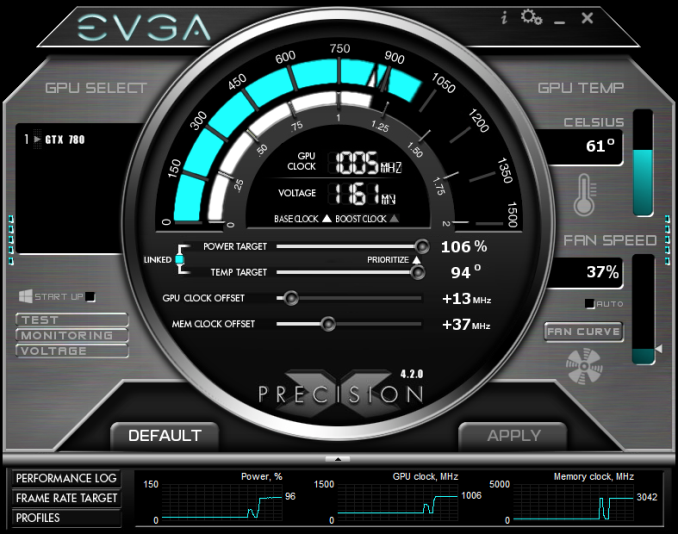The GeForce GTX 760 Roundup: Gigabyte and EVGA Compared
by Ryan Smith on October 7, 2013 2:00 PM ESTEVGA GeForce GTX 760 Superclocked ACX
Our other card for this roundup is EVGA’s GTX 760 Superclocked ACX. This card is a fully custom card, utilizing a custom EVGA PCB in conjunction with EVGA’s recently launched ACX cooler. All of this is then wrapped up with a moderate factory overclock that sees EVGA ship the card at 1072MHz core, 65MHz (9%) over the GTX 760 reference clockspeeds.
Like the 780SC ACX and 770SC ACX cards we’ve looked at previously, the 760SC ACX marks the first time we’ve seen EVGA’s new ACX cooler in this category of product. The ACX cooler is a notable departure from the norm for EVGA, who previously did not seriously involve themselves in the branded custom cooler market. With the ACX cooler EVGA is not only looking to tap into that market, alongside the larger market for open air coolers, but the company is looking to make a name for themselves based on build quality of their cooler, something EVGA’s competitors don’t always invest as heavily in and/or call as much attention to.
At its most basic level, the ACX cooler is a typical dual fan open air cooler, as we’ve seen countless times from other manufacturers. This basic design is very effective in moving large amounts of heat for relatively little noise, making the usual tradeoff of moving some of the cooling workload onto the system’s chassis (and its larger, slower fans) rather than doing the work entirely on its own. In EVGA’s case they’re using larger than typical fans for a dual fan cooler, with the ACX cooler’s fans coming in at 90mm diameter.
Meanwhile everyone has their own slight variations in design here, with EVGA focusing on running a full length heatsink to maximize their heatsink surface area. The heatsink itself is single segment heatsink with 3 large copper heatpipes from the center of the heatsink and the GPU around to each end of the heatsink. An aluminum baseplate is present on the card, but it only covers the rear half of the PCB which is sparse on components. The MOSFETs and other power delivery components are located near the front of the card, with cooling provided by the primary heatsink itself.
As for EVGA’s quality angle, the company is paying specific attention to the fans on their ACX cooler, using a fan blade design they say is optimized for strength and weight, while driving those fans with a double ball bearing motor. Much like the basic double fan design, ball bearings aren’t a major innovation in this space, but they are inconsistently used, often going unmentioned or interchanged with traditional sleeve bearings from one generation to the next. Mechanically speaking, compared to sleeve bearings, ball bearings typically have greater longevity and a bit less noise under heavy load, in exchange for a bit more noise at idle, making them a good tradeoff for a high-end card. From a practical point of view the longer lifespan of ball bearings will be the greatest gain out of this, while any noise tradeoffs are secondary as the fan itself will usually be the greater factor.
Cooling and factory overclock aside, the 760SC ACX is otherwise typical for a retail GTX 760 card. At 9.5 inches long for both the PCB and heatsink, this is the shorter of the two cards we’re looking at today, and marks the first time we’ve seen the more compact version of the ACX cooler; EVGA’s other cards were an inch longer. I/O is also standard with NVIDIA’s display I/O configuration of 2x DL-DVI, 1x HDMI, and 1x DisplayPort 1.2. Like Gigabyte, EVGA is over-delivering on power in their design; the 6pin + 8pin external PCIe power connectors will have no trouble delivering enough power for this card.
Rounding out the package is EVGA’s usual collection of software and hardware accessories, including a pair of PCIe power adapters and a DVI to VGA adapter. As far as EVGA’s software goes there’s little to be said that we haven’t said before: EVGA still shares the gold standard for software, with their fantastic Precision X overclocking utility and their OC Scanner X artifact scanning utility. Despite being based on the same RivaTuner core as MSI’s Afterburner, Precision X has diverged from Afterburner a bit over time, but as far as base overclocking and monitoring functions are concerned Precision X is among the best. And EVGA’s OC Scanner X software is second to none.
Meanwhile, as with all of EVGA’s North American cards, the 760SC ACX comes with EVGA’s standard 3 year transferable warranty, with individual 2 or 7 year extensions available for purchase upon registration, which will also unlock access to EVGA’s step-up upgrade program. Finally, the MSRP on the card is $259, $10 above the MSRP for the standard GTX 760. However with a $10 mail in rebate active as of the time this was written, it brings the card down to $249, the MSRP of the stock GTX 760 and $10 cheaper than the Gigabyte card. As a result the card is something of a no-brainer within EVGA’s lineup, as it leaves little reason to purchase the non-Superclocked version of their GTX 760 ACX. On a final note, EVGA is also running a Rise of the Triad promotion right now alongside NVIDIA’s Batman: Arkham Origins promotion. So the card comes with a pair of free games instead of just the one.


















22 Comments
View All Comments
idiot consumer - Monday, October 14, 2013 - link
Hi Ryan;I trust you in that regard. However you have to consider a large number of nvidia drivers failures:
"video driver stopped responding and has recovered" is dreaded response by thousands.
Now:
"And right now we can't reproduce any NVIDIA driver stability issues (and not for a lack of trying)."
response despite many forums full of frustrating users, is oil to the fire. This is response of nvidia and Micro$soft. After spending many hours collecting info I have found the way to cure the problem.
Every case is different as it depends on programs installed, Micro$oft number and type of updates and user setting in nvidia control panel.
That is why brand new installations are working fine - and then = after few months dreaded driver again....
It cost me way too much time and frustration just to find that relation ie. windows7 and nvidia drivers is strange.
They do not talk to each other......when they do new drivers or windows update online....
As a result, customers are suffering.
I have fixed my two systems, not a single fault after that, but not all customers have knowledge time and nerves to fix something that should never happen.
Best regards to you - I do understand that you have to do what you do....
darrrio - Tuesday, August 5, 2014 - link
i just bought the evga right before i saw this article.. now im afraid im not sure i did the right thing. the Gigabyte is in every war nicer than the evga... what stresses me most is the temperature :(( dont know if i should refund the card and get a Gigabyte..